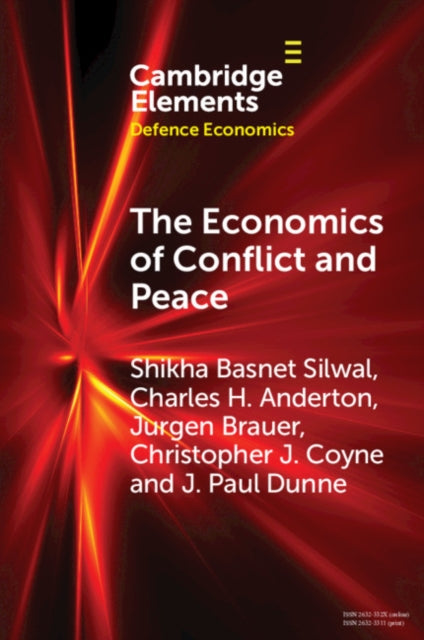Shikha BasnetSilwal,Charles H.Anderton,Jurgen Brauer,Christopher J.Coyne,J. PaulDunne
Economics of Conflict and Peace: History and Applications
Economics of Conflict and Peace: History and Applications
YOU SAVE £0.86
- Condition: Brand new
- UK Delivery times: Usually arrives within 2 - 3 working days
- UK Shipping: Fee starts at £2.39. Subject to product weight & dimension
Bulk ordering. Want 15 or more copies? Get a personalised quote and bigger discounts. Learn more about bulk orders.
Couldn't load pickup availability
- More about Economics of Conflict and Peace: History and Applications
This Element provides a comprehensive overview of the economics of conflict and peace, including its orthodox and heterodox history of thought, current theories, and evidence. It serves as a baseline account for future research in the field.
\n Format: Paperback / softback
\n Length: 75 pages
\n Publication date: 24 June 2021
\n Publisher: Cambridge University Press
\n
This Element serves as an introduction to the field of economics of conflict and peace, written with a readership in mind that includes students, general readers, and economists alike. It provides a relatively comprehensive, systematic, and detailed overview of the field's orthodox and heterodox history of thought, as well as its current theories and evidence. The authors view this Element as a foundational account that can be built upon to create a future, more comprehensive and developed work on the economics of peace, economic growth, and human development.
In total, the Element contextualizes the field of conflict and peace economics, outlines its history of thought, highlights examples of current theoretical and empirical scholarship in the field, and maps trajectories for future research.
The study of economics of conflict and peace is a multidisciplinary field that draws upon insights from various disciplines, including political science, sociology, psychology, and economics. It examines the economic factors that contribute to the occurrence, resolution, and prevention of conflicts, as well as the economic consequences of conflict on individuals, communities, and societies.
One of the key themes in the economics of conflict and peace is the role of economic inequality. Research has shown that economic inequality can exacerbate conflict by creating social tensions and grievances that can be exploited by political actors or extremist groups. For example, in countries with high levels of income inequality, there may be a greater risk of civil unrest and political instability.
Another important theme in the economics of conflict and peace is the role of institutions. Research has shown that effective institutions, such as strong rule of law, accountable government, and a well-functioning market economy, can reduce the risk of conflict and promote economic development. For example, countries with strong institutions are more likely to invest in education and healthcare, which can improve the well-being of their citizens and reduce the likelihood of conflict.
The economics of conflict and peace also examines the role of foreign aid and development assistance in promoting peace and economic development. Research has shown that foreign aid can be an effective tool for promoting peace and stability, particularly in countries that have experienced conflict or are in the process of recovering from it. However, there are also concerns about the effectiveness of foreign aid, particularly in countries that have experienced corruption or poor governance.
In addition to these themes, the economics of conflict and peace also examines the role of technology and innovation in promoting peace and economic development. Research has shown that technology and innovation can be used to create new opportunities for economic growth and development, particularly in countries that have been affected by conflict. For example, technology can be used to improve access to education and healthcare, which can promote social and economic development.
Overall, the economics of conflict and peace is a rapidly evolving field that is making significant contributions to our understanding of the factors that contribute to conflict and peace. By examining the economic factors that contribute to conflict and the economic consequences of conflict, we can develop more effective strategies for promoting peace and economic development.
\n Weight: 144g\n
Dimension: 152 x 226 x 8 (mm)\n
ISBN-13: 9781108926249\n \n
This item can be found in:
UK and International shipping information
UK and International shipping information
UK Delivery and returns information:
- Delivery within 2 - 3 days when ordering in the UK.
- Shipping fee for UK customers from £2.39. Fully tracked shipping service available.
- Returns policy: Return within 30 days of receipt for full refund.
International deliveries:
Shulph Ink now ships to Australia, Belgium, Canada, France, Germany, Ireland, Italy, India, Luxembourg Saudi Arabia, Singapore, Spain, Netherlands, New Zealand, United Arab Emirates, United States of America.
- Delivery times: within 5 - 10 days for international orders.
- Shipping fee: charges vary for overseas orders. Only tracked services are available for most international orders. Some countries have untracked shipping options.
- Customs charges: If ordering to addresses outside the United Kingdom, you may or may not incur additional customs and duties fees during local delivery.


